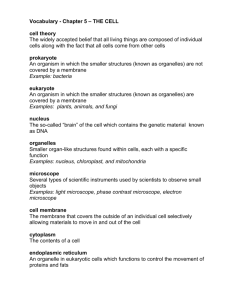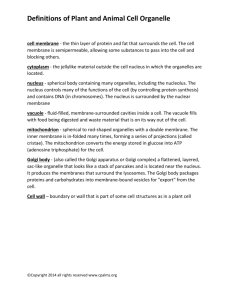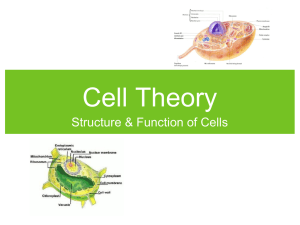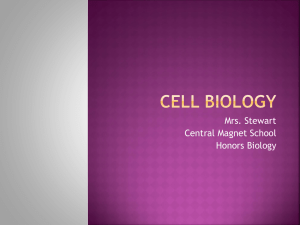Microscope and Cell
advertisement
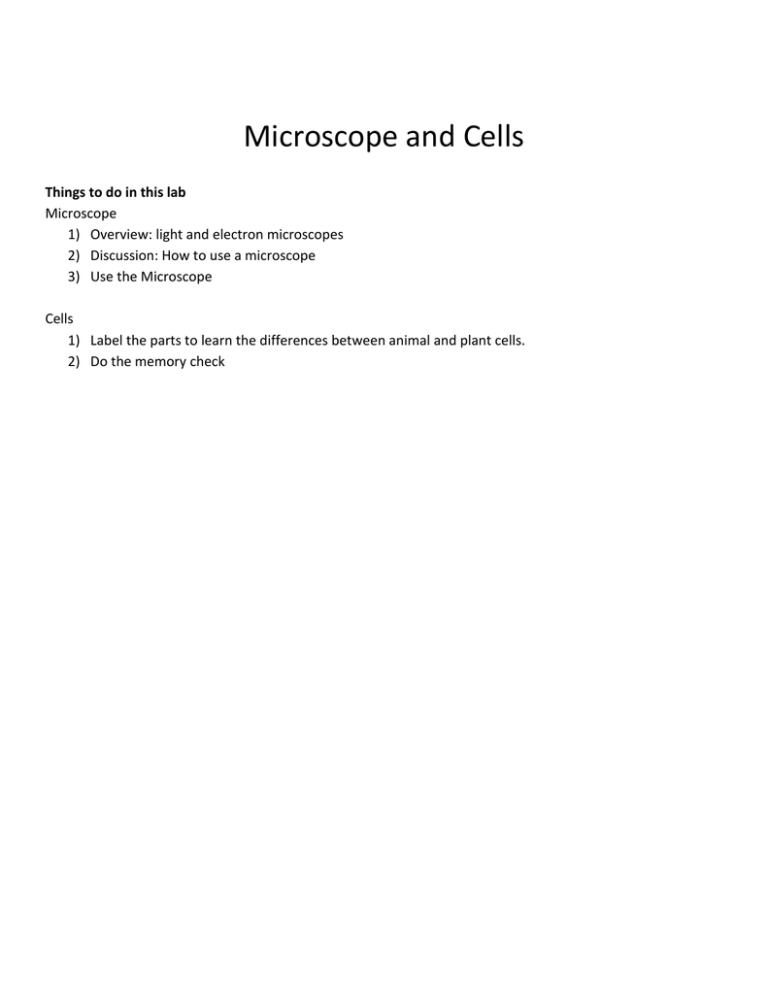
Microscope and Cells Things to do in this lab Microscope 1) Overview: light and electron microscopes 2) Discussion: How to use a microscope 3) Use the Microscope Cells 1) Label the parts to learn the differences between animal and plant cells. 2) Do the memory check Complete the comparison chart Light microscope Beam of energy lenses are made of How to focus Electron microscope Using the terms listed below, label the microscope diagram arm - this attaches the eyepiece and body tube to the base. base - this supports the microscope. body tube - the tube that supports the eyepiece. coarse focus adjustment - a knob that makes large adjustments to the focus. diaphragm - an adjustable opening under the stage, allowing different amounts of light onto the stage. eyepiece - where you place your eye. fine focus adjustment - a knob that makes small adjustments to the focus (it is often smaller than the coarse focus knob). high-power objective - a large lens with high magnifying power. inclination joint - an adjustable joint that lets the arm tilt at various angles. low-power objective - a small lens with low magnifying power. mirror (or light source) - this directs light upwards onto the slide. revolving nosepiece - the rotating device that holds the objectives (lenses). stage - the platform on which a slide is placed. stage clips - metal clips that hold a slide securely onto the stage. Tips For Using your Microscope 1) Make sure your light is turned up to full power and your iris/aperture is completely open. The majority of the time when students say their microscope is broken, one of these two settings is wrong. As you start to use the microscope, you may – especially at low power – choose to turn down the light. That’s OK, but always start with it wide open. 2) Put your slide in the slide holder of the stage. If you don’t do this, it will be difficult to move the slide small amounts. 3) Always start by using the low power objective. Many people call this a “scanning” objective because it allows to scan the slide quickly and find things that might be interesting at higher magnifications. This lower power/scan is the best way to find things; if you try to find things with a higher magnification you will probably be frustrated. DO NOT TRY TO USE HIGHER POWER OBJECTIVES IF YOU HAVE NOT FOUND THE ITEM WITH THE SCANNING OBJECTIVE 4) Do your initial focusing with the coarse focus knob 5) Higher magnifications need higher more light. If you move to a more powerful objective, you will need to increase the light 6) When you go to higher power, you will need to refocus. Try to do this with the fine focus knob. That is usually faster and easier than using the coarse focus knob. Things to do with your microscope in this lab 1) Look at the letter ‘e’. Notice the way the letter looks on your microscope slide, and the way it is flipped in the microscope. Remember to start on low power, then move to a higher power so you can see the fibers in the paper or dots in the ink 2) Look at crossed threads under high magnification. Remember to start on low power, then move up. You will need to refocus each time you go up in magnification. This is best to do with the fine focus knob. 3) Look at something alive. We have pond water and several commercial cultures of microbes. Sometimes we have a small insect. It is good practice to try moving the microscope stage to keep these things in view as they swim around. Calculate your microscope’s magnification Objective Lens Scanning medium High power (for dry) Oil Immersion magnification Occular Total Magnification X 10 X 10 X 10 X 10 = = = = Prokaryote Cells cocci Fewer Parts, No nucleus Bacilli Spirochete Eukaryote Cells Domain Eukaryotes contains four kingdoms: Plants, Animals, Fungi, Protists All have a nucleus (DNA lives in the nucleus) and many small parts called Organelles. To Do: Below you will find an animal cell and a plant cell. Each cell has a glossary listing parts and what they do. Label the parts in each illustration. You may use your textbook, models or posters to check your work. Parts of A plant cell amyloplast - an organelle in some plant cells that stores starch. Amyloplasts are found in starchy plants like tubers and fruits. ATP - ATP is short for adenosine triphosphate; it is a high-energy molecule used for energy storage by organisms. In plant cells, ATP is produced in the cristae ofmitochondria and chloroplasts. cell membrane - the thin layer of protein and fat that surrounds the cell, but is inside the cell wall. The cell membrane is semipermeable, allowing some substances to pass into the cell and blocking others. cell wall - a thick, rigid membrane that surrounds a plant cell. This layer of cellulose fiber gives the cell most of its support and structure. The cell wall also bonds with other cell walls to form the structure of the plant. centrosome - (also called the "microtubule organizing center") a small body located near the nucleus - it has a dense center and radiating tubules. The centrosomes is where microtubules are made. During cell division (mitosis), the centrosome divides and the two parts move to opposite sides of the dividing cell. Unlike the centrosomes in animal cells, plant cell centrosomes do not have centrioles. chlorophyll - chlorophyll is a molecule that can use light energy from sunlight to turn water and carbon dioxide gas into sugar and oxygen (this process is calledphotosynthesis). Chlorophyll is magnesium based and is usually green. chloroplast - an elongated or disc-shaped organelle containing chlorophyll. Photosynthesis (in which energy from sunlight is converted into chemical energy - food) takes place in the chloroplasts. christae - (singular crista) the multiply-folded inner membrane of a cell's mitochondrion that are finger-like projections. The walls of the cristae are the site of the cell's energy production (it is where ATP is generated). cytoplasm - the jellylike material outside the cell nucleus in which the organelles are located. Golgi body - (also called the golgi apparatus or golgi complex) a flattened, layered, sac-like organelle that looks like a stack of pancakes and is located near the nucleus. The golgi body packages proteins and carbohydrates into membranebound vesicles for "export" from the cell. granum - (plural grana) A stack of thylakoid disks within the chloroplast is called a granum. mitochondrion - spherical to rod-shaped organelles with a double membrane. The inner membrane is infolded many times, forming a series of projections (called cristae). The mitochondrion converts the energy stored in glucose into ATP (adenosine triphosphate) for the cell. nuclear membrane - the membrane that surrounds the nucleus. nucleolus - an organelle within the nucleus - it is where ribosomal RNA is produced. nucleus - spherical body containing many organelles, including the nucleolus. The nucleus controls many of the functions of the cell (by controlling protein synthesis) and contains DNA (in chromosomes). The nucleus is surrounded by the nuclear membrane photosynthesis - a process in which plants convert sunlight, water, and carbon dioxide into food energy (sugars and starches), oxygen and water. Chlorophyll or closely-related pigments (substances that color the plant) are essential to the photosynthetic process. ribosome - small organelles composed of RNA-rich cytoplasmic granules that are sites of protein synthesis. rough endoplasmic reticulum - (rough ER) a vast system of interconnected, membranous, infolded and convoluted sacks that are located in the cell's cytoplasm (the ER is continuous with the outer nuclear membrane). Rough ER is covered with ribosomes that give it a rough appearance. Rough ER transport materials through the cell and produces proteins in sacks called cisternae (which are sent to the Golgi body, or inserted into the cell membrane). smooth endoplasmic reticulum - (smooth ER) a vast system of interconnected, membranous, infolded and convoluted tubes that are located in the cell's cytoplasm (the ER is continuous with the outer nuclear membrane). The space within the ER is called the ER lumen. Smooth ER transport materials through the cell. It contains enzymes and produces and digests lipids (fats) and membrane proteins; smooth ER buds off from rough ER, moving the newly-made proteins and lipids to the Golgi body and membranes stroma - part of the chloroplasts in plant cells, located within the inner membrane of chloroplasts, between the grana. thylakoid disk - thylakoid disks are disk-shaped membrane structures in chloroplasts that contain chlorophyll. Chloroplasts are made up of stacks of thylakoid disks; a stack of thylakoid disks is called a granum. Photosynthesis (the production of ATP molecules from sunlight) takes place on thylakoid disks. vacuole - a large, membrane-bound space within a plant cell that is filled with fluid. Most plant cells have a single vacuole that takes up much of the cell. It helps maintain the shape of the cell. Parts of An Animal Cell cell membrane - the thin layer of protein and fat that surrounds the cell. The cell membrane is semipermeable, allowing some substances to pass into the cell and blocking others. centrosome - (also called the "microtubule organizing center") a small body located near the nucleus - it has a dense center and radiating tubules. The centrosomes is where microtubules are made. During cell division (mitosis), the centrosome divides and the two parts move to opposite sides of the dividing cell. The centriole is the dense center of the centrosome. cytoplasm - the jellylike material outside the cell nucleus in which the organelles are located. Golgi body - (also called the Golgi apparatus or golgi complex) a flattened, layered, sac-like organelle that looks like a stack of pancakes and is located near the nucleus. It produces the membranes that surround the lysosomes. The Golgi body packages proteins and carbohydrates into membrane-bound vesicles for "export" from the cell. lysosome - (also called cell vesicles) round organelles surrounded by a membrane and containing digestive enzymes. This is where the digestion of cell nutrients takes place. mitochondrion - spherical to rod-shaped organelles with a double membrane. The inner membrane is infolded many times, forming a series of projections (called cristae). The mitochondrion converts the energy stored in glucose into ATP (adenosine triphosphate) for the cell. nuclear membrane - the membrane that surrounds the nucleus. nucleolus - an organelle within the nucleus - it is where ribosomal RNA is produced. Some cells have more than one nucleolus. nucleus - spherical body containing many organelles, including the nucleolus. The nucleus controls many of the functions of the cell (by controlling protein synthesis) and contains DNA (in chromosomes). The nucleus is surrounded by the nuclear membrane. ribosome - small organelles composed of RNA-rich cytoplasmic granules that are sites of protein synthesis. rough endoplasmic reticulum - (rough ER) a vast system of interconnected, membranous, infolded and convoluted sacks that are located in the cell's cytoplasm (the ER is continuous with the outer nuclear membrane). Rough ER is covered with ribosomes that give it a rough appearance. Rough ER transports materials through the cell and produces proteins in sacks called cisternae (which are sent to the Golgi body, or inserted into the cell membrane). smooth endoplasmic reticulum - (smooth ER) a vast system of interconnected, membranous, infolded and convoluted tubes that are located in the cell's cytoplasm (the ER is continuous with the outer nuclear membrane). The space within the ER is called the ER lumen. Smooth ER transports materials through the cell. It contains enzymes and produces and digests lipids (fats) and membrane proteins; smooth ER buds off from rough ER, moving the newly-made proteins and lipids to the Golgi body, lysosomes, and membranes. vacuole - fluid-filled, membrane-surrounded cavities inside a cell. The vacuole fills with food being digested and waste material that is on its way out of the cell. Memory Check Write down the function of each organelle and check which cell type has this organelle Organelle Mitochondria Chloroplast Rough ER Smooth ER Golgi Apparatus Ribosome Nucleus Plasma membrane Cell wall Function animal plant


